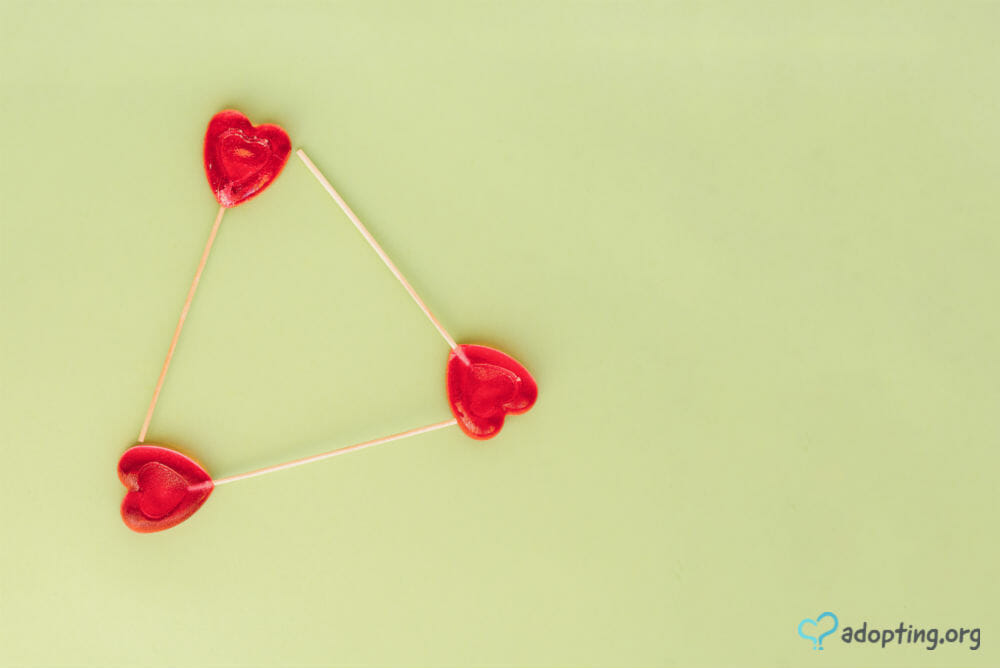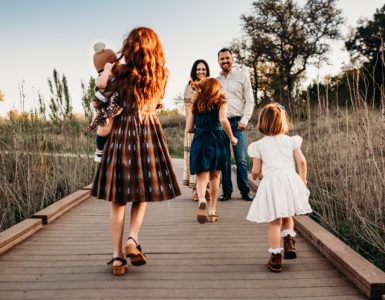
Many people with a connection to adoption are familiar with what has come to be known as the “adoption symbol.” On bumper stickers, clothing, artwork, jewelry, tattoos, logos, and in many other places, you can find the adoption symbol, which is a heart and triangle overlapping, with one shape superimposed on the other. But what does the adoption symbol represent, and where did it come from?
The adoption symbol contains two shapes, a heart and a triangle, which represent the love between the members of the adoption triad. The adoption triad is the three distinct entities present in an adoption: the adoptee, the birth family, and the adoptive family. The triangle, with equal sides and equal angles, shows that each member of the triad shares equal importance. Each member is interconnected with the other.
Even in a closed adoption, where there is no contact between the birth family and the adoptee and adoptive family, each member of the triad played an equal role in that adoption journey. The heart represents the love between all members of the triad. The selfless love of birth parents for their children, the undying gratitude and love adoptive parents have for the birth family, and the powerful, unconditional love they have for their child. An adoptee lucky enough to be in an open adoption with his or her birth family shares love not just for his adoptive parents, but for his birth family as well. Even international adoptees who may have no record or knowledge of their birth family feel love and gratitude for their birth family.
Though the reality of adoption is that all adoption stems from loss, there is also a tremendous amount of love each member of the triad gains from any adoption story, which the adoption symbol depicts. The adoption symbol is simple, but it has a powerful meaning.
As an adoptive parent, the adoption symbol is a powerful but simple way to share my adoption connection with the world. Those who are members of the adoption community often like to wear something with or get a tattoo of the adoption symbol as a visible sign to others that they are part of the adoption community. The adoption symbol is also a great conversation starter with those who are unfamiliar with adoption, as the symbol itself succinctly describes the modern adoption experience.
If you have been touched by adoption, consider using a piece of jewelry or article of clothing with the adoption symbol on it as your way to let the world know your life has been touched by adoption and as a way to educate others and advocate for adoption. While you may occasionally get invasive questions from others asking for personal details about your child’s adoption story, the majority of people who strike up a conversation with you about the adoption symbol are genuine in their desire to want to learn more about adoption. You also never know when you may meet someone with a connection to adoption: a fellow adoptive parent, an adoptee, a birth parent, or someone considering adoption. By wearing the adoption symbol, you could possibly create meaningful connections with others.
[dfp_ads id=46]For adoptees, the adoption symbol can help them feel connected to both of their families, even if they have no contact with or knowledge of their birth family. Much like with adoptive parents, wearing something featuring the adoption symbol can also help adoptees connect with other members of the adoption community, including other adoptees. It’s a subtle way to catch the eye of someone who is knowledgeable about what the adoption symbol means. For many adoptees who don’t have a relationship with their birth family, the adoption symbol can be a source of strength, reminding them that even though they may not know their birth family, they know that their birth family loves them.For birth parents, especially birth mothers, there can still be a stigma associated with placing your child for adoption. The adoption symbol is discreet enough that wearing it doesn’t loudly announce your status as a birth parent to the world. Many birth parents find that jewelry or a tattoo of the adoption symbol can serve as a visual that helps them heal while they process the tremendous grief that comes along with placing a child for adoption.
Most of the adoption stories we see in the media are told from the perspective of the adoptive parents. As an adoptive parent myself, I have a soft spot for other adoptive parents, but it is important to realize that we should not be the center of our child’s story and that we shouldn’t share all the details of her adoption story with everyone we know.
The adoption symbol can be a powerful visual reminder for adoptive parents that each member of the triad is important, and each member should have a voice. As an adoptive parent, it is imperative to listen not just to our own children, but to the voices of other adoptees and birth families. Not every adoption story is a fairytale, and sometimes as adoptive parents, it can be hard to hear that and to accept the reality that our children, whether or not they realize or express it, undoubtedly feel grief over being separated from their first family.
The adoption industry itself is also far from perfect, and listening to the stories of birth parents who had agencies or adoptive families break their promise to them should encourage adoptive parents to not only seek out ethical adoption professionals, but also to ensure that we honor the wishes of our child’s birth family. It is also important that we accept and understand that every child’s birth family plays an important role in who they are. Even if they make decisions we may not agree with, or if they chose to have no contact with us, our child is who he is not just because of our influence in his life, but also because of the contributions his birth family made to him genetically and culturally. The adoption symbol encourages all members of the triad to celebrate their connection to adoption, as well as to honor it, and advocate for all members of the triad to have an equal voice.



